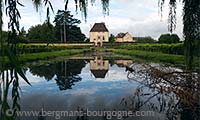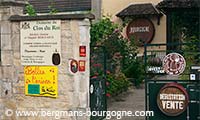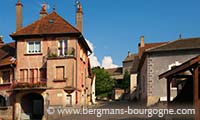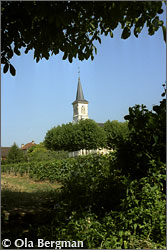
his is the home of the mighty Corton hill with its 160.20 hectares of grand cru land, producing grand cru wine of both colours. Not counting the minuscule plot inside the Musigny vineyard that Domaine Comte Georges de Vogüe has planted with chardonnay this is the only grand cru appellation in Burgundy that produces both red and white wine. About three quarters belong to Aloxe-Corton (pronounced Alosse-Corton); the rest is divided between the neighbouring communes of Ladoix-Serrigny and Pernand-Vergelesses. Not even 200 people live here, still there are three chateaux in this quiet little village – Château Corton André (owned by the négociant Corton André), Château Corton Grancey and Château de Corton. The first two are located along the Rue des Cortons leading out of the village to the north, while the last one can be found on the opposite side of Aloxe-Corton.

Today the Château Corton Grancey is owned by Louis Latour. It was originally built in 1749 by Charles Antoine Gabriel Lebault, president of the Parliament of Burgundy and seigneur of Pichanges, just north of Dijon. After his death on November 15, 1774 the chateau was passed on to his daughter Claudine Geneviève Lebault, who married Joseph-Gabriel de Cordoue-Descordes, seigneur of Auras among other places. Their son, Joseph-Gabriel de Cordoue-Descordes, born in Aloxe-Corton on September 17, 1778 inherited what his grandfather had built. In 1834 he had a cuverie and cellars built nearby, just below Les Perrières. After his death on October 26, 1857 the estate was taken over by Marie-François-Ernest Galliot de Mandat, count of Grancey-le-Château, and his wife Catherine-Eugénie-Rhingarde de Cordue. When they passed away in 1887 and 1890, Louis Latour aquired the chateau, the cuverie and the vineyards.
The only commerce is the Caveau Aloxe-Corton, selling the wines of eight Aloxe-Corton vignerons: Jacques Barberet, Pierre Bize, B. Bretin, Maurice Chapuis, Bruno Colin, Franck Follin-Arbelet, André Masson and Didier Meuneveaux. Just across the street, right by the village square/parking is Domaine Michel Voarick whose tasting room is open all year around. The village square is not exactly large; four cars parked here and the place is crowded.
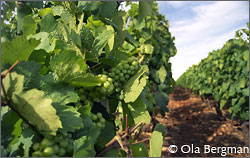
There is also a restaurant run by Domaine Comte Senard at Clos des Meix where you can have lunch together with a range of their wines. The restaurant, as well as the adjoining shop, is open from April 1st until the third weekend of November.
Aloxe-Corton is tightly surrounded by vines, so tightly that the possibilities to build new houses are long gone. Unless you rip up some vines, that is. But I guess that this is not an option in this part of the world. There are even vines inside the village – the premier cru of Clos du Chapître. Right behind the village is the Corton hill with its characteristic forest, Bois de Corton, at the top. The commune covers a total of 263 hectares. 245 of these are planted with vines.
From the Ladoix end, via Aloxe-Corton, to the Pernand end almost three quarters around the Corton hill is covered with vines. The middle and upper parts are all grand cru land, while the vineyards below are premier cru and communal land. And in true Burgundian manner some of the Aloxe-Corton vines (8,46 ha) are within the Ladoix-Serrigny boundaries – the six premier crus of Clos des Maréchaudes, La Maréchaude, Les Petites Lolières, Les Moutottes, La Coutière and La Toppe au Vert.
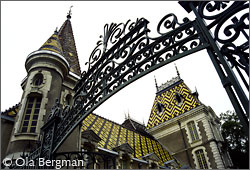 But it is within the grand cru that things really get complicated. In the Pernand part of Corton it is simple; if planted with pinot noir it makes Corton and if planted with chardonnay it makes Corton-Charlemagne. But in Aloxe and Ladoix this only applies to certain climats. In others the rule is that both chardonnay and pinot noir make Corton. There are also 25 lieu-dits that may be used on the label together with Corton – Les Bressandes, Les Chaumes, Clos des Meix, Clos du Roi, Les Combes, Le Corton, Les Fiètres, Les Grèves, Les Manguettes, Les Maréchaudes, Le Meix Lallemand, Les Paulands, Les Perrières, Les Pougets, Les Renardes, La Vigne au Saint, Basses Mourottes, Les Carrières, Clos de Cortons Faiveley, Les Grandes Lolières, Le Rognet et Corton, La Toppe au Vert and Les Vergennes.
But it is within the grand cru that things really get complicated. In the Pernand part of Corton it is simple; if planted with pinot noir it makes Corton and if planted with chardonnay it makes Corton-Charlemagne. But in Aloxe and Ladoix this only applies to certain climats. In others the rule is that both chardonnay and pinot noir make Corton. There are also 25 lieu-dits that may be used on the label together with Corton – Les Bressandes, Les Chaumes, Clos des Meix, Clos du Roi, Les Combes, Le Corton, Les Fiètres, Les Grèves, Les Manguettes, Les Maréchaudes, Le Meix Lallemand, Les Paulands, Les Perrières, Les Pougets, Les Renardes, La Vigne au Saint, Basses Mourottes, Les Carrières, Clos de Cortons Faiveley, Les Grandes Lolières, Le Rognet et Corton, La Toppe au Vert and Les Vergennes.
– There are many different wines from the Corton appellation, says Pierre Cornu at Domaine Edmond Cornu in the neighbouring village of Ladoix-Serrigny. It is very heterogeneous. The soil really expresses its true nature here. You can really taste the difference between the climats here. For example, the Bressandes is one of the most elegant, while the Renardes and the Clos du Roi are more powerful and rustic.
The Château Corton Grancey made by Beaune négociant Maison Louis Latour is a blend of five different climats - Les Bressandes (3.07 ha), Les Chaumes (1.17 ha), Les Pougets (0.88 ha), Les Perrières (5.06 ha) and Les Grèves (1.21 ha). The proportions vary depending on the character of the vintage. This wine is only produced in years when the grapes reach perfect maturity. For example, in 1991, 1994, 2000, 2004 and 2007 there was no Château Corton Grancey made.
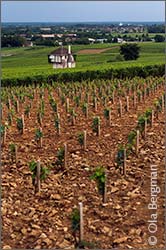 White Corton, made from chardonnay, is however a relatively recent thing. It was not until the 19th century that it slowly made its debut here. Instead there were, what we today regard as curiosities, wines like the Charlemagne Mousseux, a sparkling aligoté made by Domaine Chapuis in the late 19th/early 20th century.
White Corton, made from chardonnay, is however a relatively recent thing. It was not until the 19th century that it slowly made its debut here. Instead there were, what we today regard as curiosities, wines like the Charlemagne Mousseux, a sparkling aligoté made by Domaine Chapuis in the late 19th/early 20th century.
– In those days, the Corton hill was planted with aligoté grapes when people wanted to make white wine, explains Maurice Chapuis at Domaine Chapuis in Aloxe-Corton. The chardonnay imposed itself only after World War 1. But your have to understand that in those days white wine was a rarity in our village, and most of the hill was planted with pinot noir to make red wine, not white wine. The Languettes, Pougets, le Corton, part of Corton Renardes were planted with pinot noir. It was only in the 1970's that Corton-Charlemagne became in vogue and that Pougets or Languettes for example, were planted with chardonnay.
In the red department things were different as well. Danguy & Aubertin tell us that in 1892 when they published their book on Burgundy 240 hectares were under vines in Aloxe Corton. 50 of these were planted with gamay.
Across the three communes there are well over 150 different owners to the Corton vines. Combined with a large variety of soils this results in a broad spectrum of Cortons in bottle. Soil and orientation are of course important, but equally (or perhaps more) important is the winemaker. With so many people involved not all are able to deliver the highest possible quality.
There are other ways to make use of the Corton hill as well. It is a great place to go for a morning run. When we stayed in Ladoix-Serrigny I used to run to Aloxe-Corton and back. With Les Bressandes on one side and Clos de Rois and Les Renardes on the other it was definitely the most exclusive jogging track I have had access to. The Corton hill is also a good place to go for a picnic. Up at the top by the Bois de Corton you will have a stunning view.
In Galloroman times Aloxe was strategically located along the Roman road from Autun to Besançon. Aloxe was first mentioned in print in 696, as Hauriacum. Halfway through the ninth century the name had changed to Alussia when Moduin, bishop of Autun, decided to donate his land holdings in Aloxe to his cathedral. During the 13th and 14th centuries the name changed from Alossia, Aloxa and Alouxe to Alorsa and Alorse.
The prefix "al" in Aloxe, which is of Gallic origin, suggests an elevated place. The name Corton, that was added to Aloxe in 1862, is explained in different ways, Some explain it as a contraction of Curtis d'Othon, Othon's estate, while Danguy & Aubertin point at the Celtic word for estate or piece of property – curt, cort (curtis or cortis in Latinised form) – with no mention of Othon.
In 2008 it was announced that Burgundy's most illustrious domaine, the Domaine de la Romanée-Conti, will be present on the Corton hill from the 2009 vintage. They will be renting 1,20 hectares of Bressandes, 0,57 hectares of Clos du Roi and 0,51 hectares of Renardes from the Domaine Prince Florent de Mérode.
© 2013 Ola Bergman










